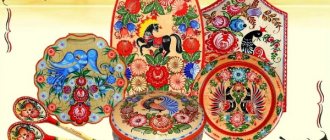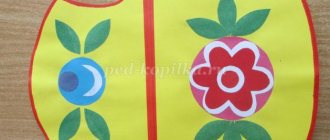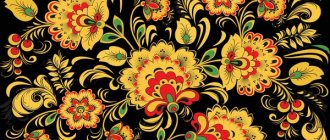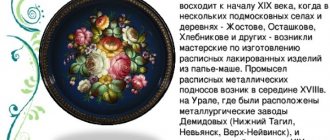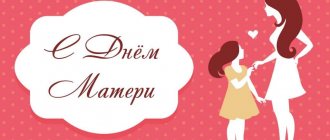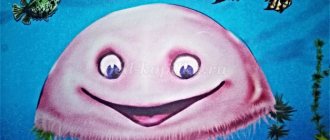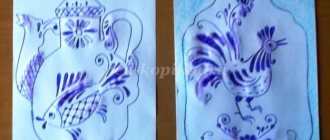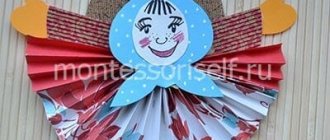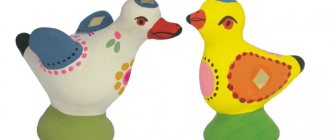A little history
History indicates that the development of wood studies led to its application on the most unexpected subjects, which included:
- furniture;
- chests;
- sled;
- utensils used indoors.
Most often there was a symbolic character, and the background tones were: green, blue and sometimes black. Particularly popular were and are drawings with specific themes, showing people and animals.
After World War I, art fell into decline, forcing specialists to look for other sources of income. The revival of the popularity of the direction is associated with the name of I.I. Oveshkov, who opened the workshop to the public.
It organized the training of appropriate personnel, which resulted in an increase in those able to process the source code. Involving a new generation in recreating images develops a sense of belonging to the culture of their country and develops artistic thinking on different levels.
Teaching children in kindergarten and primary school
For kindergarten (senior group), painting a board is one of the ways to teach a child fine art and understand it at a certain level. It is preferable to start practice on paper, as it can be used as a sketch that can be transferred to a harder material.
You just need to prepare your brushes and a few spreads from your notebook (for blanks) to get started. Consider aspects:
- paper should be taken in a format close to A4 (in albums or Whatman paper of appropriate size), and for children from five years old, the best option would be to use also less dense sheets for sketches, from which the whole idea will be transferred finally;
- You will need three brushes to get the best result: core brush, squirrel brush and flute brush. The latter is a flat brush used for small strokes that cannot be made with more substantial varieties;
- masters use oil paints in their work, and in art classes for preschoolers (fifth grade can also use templates for training) it is better to teach with gouache. The standard set includes twelve colors, of which you need to take only eight: white, cherry, bright blue, scarlet, yellow, dark green and red. The last 3 must be mixed, and the remaining ones can be used separately.
At a younger age, decorative drawing is easier to demonstrate to teachers step by step (for beginner adults, a similar method of work is also suitable) in the following sequence:
- sketch the diagram in natural size. Minor details are noted that will be carried over to the final version.
- Highlighting the center of the mosaic and the features that will be applied in each section;
- drawing each fragment thoroughly using the specified tools;
- coating the board with varnish - entrust this phase to those who are older.
Educators and teachers need to control the process at the stage of transferring the plan onto the plane in order to prevent paint from flowing out where it is needed, and to eliminate minor errors faster.
The two main sections of the illustration procedure, underpainting and animation, are performed with different brushes (in the case of floristry, shadows are also drawn between them). First you need to paint the background in an even layer, and then start adding details.
The finished product should be dried before varnishing with a transparent product that protects against fading, burnout and dampness.
First experience
A typical element of the painting is a stylized flower. It is found in almost every drawing, so it’s worth starting to get acquainted with this fascinating type of creativity. After understanding how and what to draw, you can make templates for Gorodets painting of boards and use them as stencils. Some people prefer to glue appliques, although patterns applied with a brush and paints look much more interesting. To work you will need:
- brushes of different sizes;
- a thick sheet of white paper;
- cherry gouache;
- pencil;
- eraser;
- container with water.
First, draw 4 circles with a pencil. One of them should be slightly smaller than the others. One spot is drawn on each circle, on two – closer to the middle, on the other two – on the edges. These will be the flower cores. Then petals are drawn along the entire circumference. Each such element is a narrow arc-shaped strip, the top of which protrudes beyond the edge of the circle, and the ends are directed towards the center. The arc expands towards the top, and its edges are pointed.
The main plots outlined for the most part
As a rule, they come across works:
- flowers (rosan, daisies, kupavka). Visualized in the form of a symmetrical bouquet, garland, stripe, wreath or diamond;
- birds (swans, peacocks, roosters, pigeons or cuckoos, depending on the author’s purpose);
- The “tree of life” is the personification of nature. These things contain a lot of components (compounds from plants, birds). The draftsman also draws a horse on the left and right, and occasionally lions, leopards and other exotic things.
Professionals also engage in more advanced types, such as plot painting, where there may be miniatures depicting events in real life or literary works.
Both the interior of a residential building and the streets of populated areas are depicted with the maximum possible number of subtleties. Often in such images you can see elements in the manner of domestic animals located at the feet of the owner. Another feature is the presence of vegetation in the winter landscape outside the building.
Similar crafts are usually embodied in a rectangular configuration, and the edges are decorated with ornaments. There are also round variations, installed on a shelf as decorative plates, the patterns on which are located on the edge.
The box is capable of containing on its edge a few outlines with various situations, the central one of which is placed on the lid or front wall (on the side where the structure opens).
Decorations for the New Year: decor ideas and options for decorating a house and apartment for New Year's celebrations (135 photos)- Window decoration - simple ideas and step-by-step descriptions of do-it-yourself window decoration (110 photos and videos)
Diaper cake - a step-by-step description of creating a diaper cake. 115 photos and videos of creating a gift
The description of the life of the peasants reflected the reality of the time period in which the master’s work was carried out as meaningfully as possible. Unusual displays, inscribed in a scene from everyday life, enhance the effect of what they see.
The most important actors are located in the center of the canvas - larger than the rest. Shots of tea parties, feasts, weddings and other events - always with a table where dishes are placed or other secondary objects that reveal the essence of what is happening.
Elements based on folk tales are no less popular and in demand - the plot and characters are recognizable at first sight, and the richness depends only on the imagination of the creator.
Description of folk craft
On the left bank of the Volga there is a beautiful small town called Gorodets. It was there that painting was born, which later became famous not only in Russia, but also abroad. This technique is characterized by not too complex, but very bright elements. Decorated items always have flowers; birds with luxurious plumage and dressed black horses are almost always present. The horse was previously considered a symbol of wealth, so it was depicted quite often, but now the presence of the horse in Gorodets painting is due to compliance with the canons.
Typical flowers are daisies, rosanas, roses and half-opened buds. Colorful vegetation symbolizes prosperity and health, while birds represent joy and happiness. The patterns are usually plot-based, conveying different aspects of the life of ordinary people. Here is what (and who) can most often be seen on painted items:
- city streets;
- flowers, leaves;
- birds, animals;
- dressed up young ladies and men;
- festivities;
- weddings;
- horsemen
It is interesting that people’s faces are always turned towards the viewer, while animals and birds look away. Scatterings of flowers are located along the edges, and often they are located chaotically in different places of the picture. According to the canons, painting is applied to a wooden product in stages. Craftsmen decorate cribs, cuckoo clocks, sleigh backs, boxes, salt shakers, cutting boards, spoons, decorative dishes and much more that can be used in everyday life.
In order not to accidentally spoil a useful item, it is better to start mastering the craft with drawings on paper. Hands must get used to the features of different elements.
You should prepare for the fact that you won’t be able to perfectly draw even the simplest details right away. Gradually, your fingers will “remember” how to hold the brush correctly, and over time, ornate curves and complex transitions from thin strokes to wide lines will turn out well.
Where to start
If you decide to exercise yourself or your son or daughter wants to learn it, it is not necessary to attend any courses. It’s enough to start small - find online lessons in a form convenient for you - this can be a text with illustrations, which shows how the work canvas takes on its own shape.
Other modifications are videos, coloring books, stencils, which allow you to clearly understand everything, and ultimately understand it along the way.
When doing work, it is not advisable to rush, trying to apply shades to the surface as quickly as possible - this will only lead to streaks. Use a pencil to outline the outline, but do not apply pressure.
Patchwork - technique and master class for sewing stylish and beautiful sewing with your own hands (80 photos)- Tilda doll - a master class in sewing toys with your own hands. 125 photos of the best toy models
How to make a car out of paper: step-by-step description of how to quickly and easily build a high-quality car (75 photos + video)
Another feature of the operation is the concentration of dark spots on top of light ones. All you have to do is choose the direction in which you are going to create, and therefore you will master Gorodets painting. To improve your skills, you can first select paintings online, and then reproduce your own textures or leitmotifs.
Initially, it is far from perfect, but with constant repetition and honing of the skill, the result will become better, giving the right to trade professionally and on a permanent basis.
Video materials
A short slideshow accompanied by folk music with photographs of products from Gorodets craftsmen
Suitable for display on a projector.
https://youtube.com/watch?v=PvMa-4MUTEM
Master class “Drawing a berry”
Master class “Drawing underpainting”
Master class “Shadow and revival”
Open lesson on visual arts “Gorodets painting”
Decorative drawing classes expand children's knowledge about folk crafts, music, and folklore. The pupils' vocabulary is actively expanding. Palekh, Khokhloma, Gzhel, Gorodets - these words will be filled with meaning for the children and will be preserved in their memory with bright, fabulous images. Studying the features and techniques of Gorodets painting contributes to the development of spatial and figurative thinking, the ability to independently plan actions and construct a composition. By creating drawings based on Gorodets painting, the children themselves can choose the shape of the workpiece, think over the type of future ornament and choose colors for work. The works of masters from Gorodets are close to children with their colorfulness and simplicity of composition, encouraging independent creativity.
